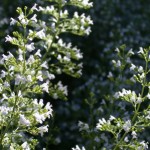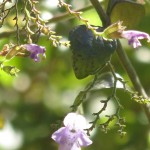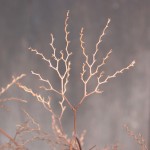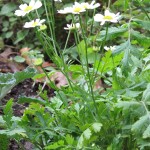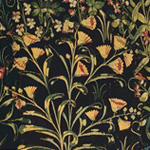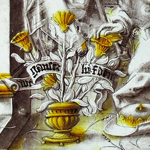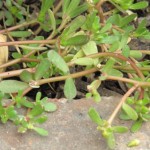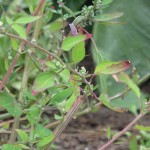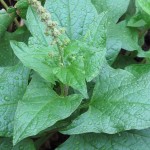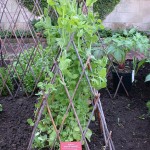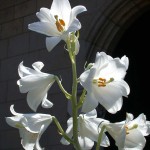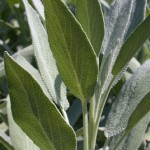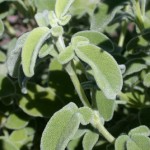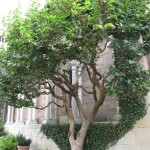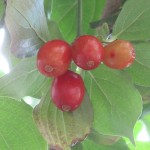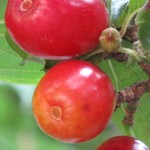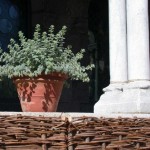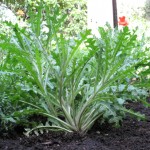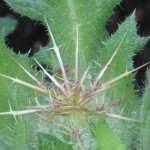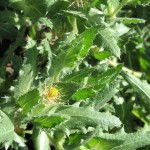Archive for the ‘Medicinal Plants’ Category
Wednesday, November 17, 2010
The pretty, fragrant lesser calamint flourishes in all three of the enclosed gardens at The Cloisters. Each small shrub bears a host of delicate little flowers from late summer through frost. Above, from left to right: The lipped flowers of calamint are characteristic of members of the Labiatae, or mint, family; cold weather brings out the purplish cast in the flowers; calamint is beautiful even in winter, when the fine stems are bare.
The larger-flowered calamint, known as Calamintha grandiflora, is frequently grown in modern gardens, but the lesser calamint, Calamintha nepeta, is the calamint of the Middle Ages. Read more »
Tags: calamint, Calamintha grandiflora, Calamintha nepeta, Calamintha officinalis, Cuxa Garden, marjoram, nepitella, Satureja hortensis, Satureja montana, savory, White Cloud
Posted in Food and Beverage Plants, Gardening at The Cloisters, Medicinal Plants | Comments (1)
Friday, November 12, 2010
The common name of feverfew is derived from the Latin febrifuge. Botanists now place this member of the aster family in the genus Tanacetum, but feverfew was formerly known both as Chrysanthemum parthenium and Pyrethrum parthenium and may be listed as such in older sources. Above, left and center: Feverfew??growing in Bonnefont garden in November; right: the only feverfew plant depicted in the Unicorn Tapestries appears between the feet of the hunter poised to spear the quarry in The Unicorn Defends Itself.
Feverfew (Tanacetum parthenium) is a strongly aromatic herb in the aster family; it is closely related to costmary (Tanacetum balsamita) and to tansy (Tanacetum officinale), both of which also grow in Bonnefont garden. While tansy has been employed as a medicine, a food, and an insect repellent, feverfew is strictly a medicinal herb. The medieval name of this antipyretic??species is derived from the Latin febrifuge and refers to its usefulness in driving off fever. Read more »
Tags: antipyretic, balsamita, Capitulare de Villis, Centaurium erythraea, centaury, Chrysanthemum, costmary, febrifuge, febrifugiam, feverfew, herb, Herbarius Latinus, Hortulus, Pyrethrum, Tanacetum, Tanacetum officinale, tansy, Unicorn tapestries, Walahfrid Strabo
Posted in Gardening at The Cloisters, Medicinal Plants, Plants in Medieval Art | Comments (0)
Friday, November 5, 2010
The golden flowers of the calendula, said to bloom in every month of the year, figure in the art, literature, and medicine of the Middle Ages. Called “golds” in medieval English, the flowers were associated with the Virgin and came to be known as “marigolds” by the sixteenth century. Above, from left to right: Detail of a large calendula plant, bearing many blooms, which appears below the golden fence enclosing The Unicorn in Captivity; a calendula blooming in December; the daisy-like flower is often shown in profile in medieval depictions, as in this detail of an urn with three calendula flowers shown in the foreground of a silver-stain roundel depicting the Adoration of the Magi.
‘Golde [Marigold] is bitter in savour
Fayr and zelw [yellow] is his flowur
Ye golde flour is good to sene
It makyth ye syth bryth and clene
Wyscely to lokyn on his flowres
Drawyth owt of ye heed wikked hirores
[humours]. . . .
Loke wyscely on golde erly at morwe [morning]
Yat day fro feures it schall ye borwe:
Ye odour of ye golde is good to smelle.’
???From the herbal of Macer, as quoted in A Modern Herbal
Read more »
Tags: Adoration of the Magi, calendula, Crocus sativus, Konrad von W??rzburg, Macer, marigold, pottage, saffron, Unicorn in Captivity
Posted in Gardening at The Cloisters, Medicinal Plants, Plants in Medieval Art | Comments (0)
Friday, October 29, 2010
The edible weeds that grew among the cultivated vegetables in the medieval kitchen garden were also harvested and used as potherbs. Above, from left to right: purslane, a succulent weed of fertile soils, is a common weed in our own vegetable gardens; lamb’s quarters, also known as “fat hen,” is now a very common weed in the United States; Good King Henry is related to the nutritious lamb’s quarters and was cultivated as a vegetable. Photographs by Corey Eilhardt.
A weed is a plant you don’t want. An herb is a plant with a use. But many of the “weedy” species that are considered garden nuisances today were actually valued in the Middle Ages. Edible weeds growing in the kitchen garden, along with the cultivated vegetables, were used in pottage, a basic medieval dish. (For more on pottage, see last week’s post, “Colewort and Kale.”) Read more »
Tags: cabbage, Chenopodium album, Chenopodium bonus-henricus, dandelion, Good King Henry, herb, kale, lamb's quarters, leek, Portulaca oleracea, pottage, purslane, ribwort plantain, weed
Posted in Food and Beverage Plants, Gardening at The Cloisters, Medicinal Plants | Comments (4)
Friday, October 15, 2010
Many of the healing herbs, flowers, and foodstuffs mentioned by the twelfth-century Benedictine abbess Hildegard of Bingen in her great work Physica are grown in Bonnefont garden at The Cloisters. Above, from left to right: Field peas (Pisum sativum arvense,??variety ‘Blue Pod Capucijners’); Madonna lily (Lilium candidum); milk thistle (Silybum marianum).?? Photographs from the Gardens archives.
It is the first book in which a woman discusses plants and trees in relation to their physical properties. It is the earliest book on natural history to be done in Germany and is, in essence, the foundation of botanical study there. It influenced the 16th-century works of Brunfels, Fuchs, and Bock, the so-called ???German fathers of botany,??? but the fact is that German botany is more indebted to a ???mother.???
???Frank Anderson on the Physica, from An Illustrated History of the Herbals
Certain plants grow from air. These plants are gentle on the digestion and possess a happy nature, producing happiness in anyone who eats them. They are like a person???s hair in that they are always light and airy. Certain other herbs are windy, since they grow from the wind. These herbs are dry, and heavy on one???s digestion. They are of a sad nature, making the person who eats them sad. They are comparable to human perspiration. Moreover, there are herbs which are fatal as human food . . . they are comparable to human excrement.
???From Book I of the Physica, translated by Priscilla Throop
Hildegard of Bingen, Benedictine abbess, visionary, poet, dramatist, composer, and the most learned woman of the twelfth century, wrote the Physica, or Natural Science, about the year 1150. Read more »
Tags: Bonnefont Garden, field peas, Hildegard von Bingen, lily, medicinal plant, milk thistle, Silybum marianum
Posted in Botany for Gardeners, Gardening at The Cloisters, Medicinal Plants, Plants in Medieval Art | Comments (4)
Friday, September 24, 2010
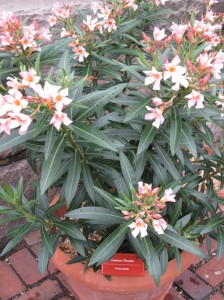
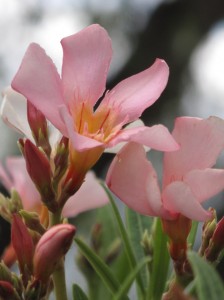
Above, from left to right: Nerium oleander, a tender evergreen shrub native to the Mediterranean, is grown in pots at The Cloisters and brought indoors for the winter. Oleander belongs to the Apocynaceae, or Dogbane family, which contains many poisonous species. The five petals of the oleander flower are fused at the base and form a tube; the form of the flower is typical of this botanical family. Photographs by Corey Eilhardt.
Nerion, which some call Rododaphne, some Rhododendron . . . grows in enclosed greens and sea-bordering places & in places near rivers. But ye flower and the leaves have a power destructive of dogs & of Asses & of Mules & and of most four-footed living creatures, but a preserving one of men, being drank with wine against the bitings of venemous beasts & ye more if you mixed it with Rue, but ye more weak sort of living creature, as goats & sheep, die, if they drink ye maceration of them.
???Dioscorides, De Materia Medica, Book IV, 82
Read more »
Tags: Apocynaceae, Dioscorides, Dogbane, Hortus Sanitatis, Nerium oleander
Posted in Gardening at The Cloisters, Medicinal Plants | Comments (2)
Tuesday, September 7, 2010
Sage, known by Latin epithets such as Salvia salvatrix, was a healing plant of great renown throughout the Middle Ages, although it was also valued as a culinary herb. Above, left: Salvia officinalis, the common garden sage, growing in a bed devoted to kitchen plants in Bonnefont garden; center: a detail from The Unicorn is Found, showing Salvia officinalis in flower; right: Greek sage or three-lobed sage (Salvia fruticosa) is not hardy in our climate, and is grown in pots and brought under cover in winter. The medicinal properties of this species were celebrated in antiquity and were conflated with those of S. officinalis.
Why should a man die in whose garden grows sage?
Against the power of death there is not medicine in our gardens
But Sage calms the nerves, takes away hand
Tremors, and helps cure fever.
Sage, castoreum, lavender, primrose,
Nasturtium, and athanasia cure paralytic parts of the body.
O sage the savior, of nature the conciliator!
???From Page Ten of the Regimen Sanitatis Salernitanum (A Salernitan Regimen of Health). See the Gode Cookery website to read the entire poem.
Cur moriatur homo cui salvia crescit in horto? (Why should a man die who has sage growing in his garden?) This much-quoted Latin adage is from the famous medieval didactic poem on maintaining good health, the Regimen Sanitatis Salernitanum. Read more »
Tags: culinary herb, Dioscorides, Gode cookery, rugose, sage, salvia fruticosa, salvia officinalis, salvia salvatrix, Theophrastus
Posted in Food and Beverage Plants, Medicinal Plants, Plants in Medieval Art | Comments (0)
Friday, August 13, 2010
Above, from left to right: A mature cornelian cherry (Cornus mas) established against the east wall of Bonnefont garden; the foliage of Cornus mas is typical of the dogwood family to which it belongs; the tart red fruits, known as cornels, don’t ripen fully until after they fall from the tree in late July and early August. Photographs by Corey Eilhardt.
A native of dry, deciduous forests in central and southern Europe and western Asia, the cornelian cherry is a relative of our own flowering dogwood, Cornus florida. The fruit of the cornelian cherry is classified botanically as a drupe, as is the fruit of the true cherry, Prunus cerasus, but the two plants are in no way related. Although the fruits are unfamiliar to Americans, Cornus mas is very widely grown in this country as a small ornamental tree or as a multi-stemmed shrub, prized for the host of little yellow blossoms that veil the naked stems and branches in early March. Read more »
Tags: acorn, Alan Davidson, cherry, Circe, cornel, cornelian, Cornus florida, cornus mas, Dioscorides, drupe, Giacomo Castelvetro, Hildegard von Bingen, Homer, Hortus Sanitatis, kizilchik, Lee Reich, medlar, Prunus cerasus, quince
Posted in Food and Beverage Plants, Medicinal Plants | Comments (5)
Friday, August 6, 2010
Above: The left and center image show the true or “right dittany” of Crete (Origanum dictamnus), a tender Mediterranean species grown in pots in Bonnefont garden. This pretty relative of the culinary oreganos is endemic to the island, and is found growing wild only in the mountains there. The small, purplish-pink flowers are borne on long-lasting bracts in late summer and fall. The image on the right shows Dictamnus albus, known as white dittany or fraxinella, which is a botanically unrelated species. Medieval herbalists seem to have transferred both the name and the??marvelous properties that the ancients ascribed to true dittany to this herb.
Origanum dictamnus, with its round, woolly gray leaves,??rosy??bracts and delicate purplish-pink flowers, is the prettiest of the tender medieval species grown in pots in Bonnefont garden, and the most difficult for us to grow. One of a number of species endemic to the mountains of Crete, the wild plant is only found growing in the crevices of limestone gorges and ravines (see image). Known as diktamnon in Greek, it is said to be named after Mount Dikti. Read more »
Tags: Aeneas, antidote, Aristotle, artemidon, Artemis, Bonnefont Garden, Cos, Crete, diktamnon, Dioscorides, Hellmut Baumann, Hippocrates, Mount Ida, Origanum dictamnus, snake, snakebite, Theophrastus, venom, Venus, Virgil, William Turner
Posted in Fragrant Plants, Gardening at The Cloisters, Medicinal Plants | Comments (1)
Friday, July 30, 2010
Above: Three images of the blessed thistle (Cnicus benedictus). The low stature and unremarkable appearance of this plant belie its medieval reputation as a plague cure and a panacea. The lax stems and spiny, light green leaves are covered with a fine, white down; the spines that subtend the developing flowerhead are a protection against grazing animals. The yellow flowers of this annual thistle appear in July; once the seeds have set, the plant dies. Photographs by Corey Eilhardt.
The humble Cnicus benedictus, a plant of waste ground and stony soil native to the Mediterranean, was a medieval panacea whose reputation survived undiminished into the Renaissance. The sixteenth-century English herbalist John Gerard notes that this wild medicinal plant of southern Europe was “diligently cherished in gardens in these Northern parts.” Gerard also attests that the herb was known everywhere in Europe by the medieval Latin name Carduus benedictus; the common names by which it is known today preserve this designation: blessed or holy thistle in English, benedikten distel in German; chardon b??nit or chardon santo in French, cardo benedetto in Italian, cardo bendito in Spanish.
Read more »
Tags: bitter, blessed thistle, Carduus benedictus, carline thistle, cataplasm, cnecos, Cnicus benedictus, Dioscorides, earbes Carduus Benedictus and Angelica, invasive, John Gerard, Maude Grieve, panacea, pestilence, plague, Pliny, Rufinus, Silybum marianum, thistle, Thomas Brasbridge, weed
Posted in Gardening at The Cloisters, Medicinal Plants | Comments (1)
